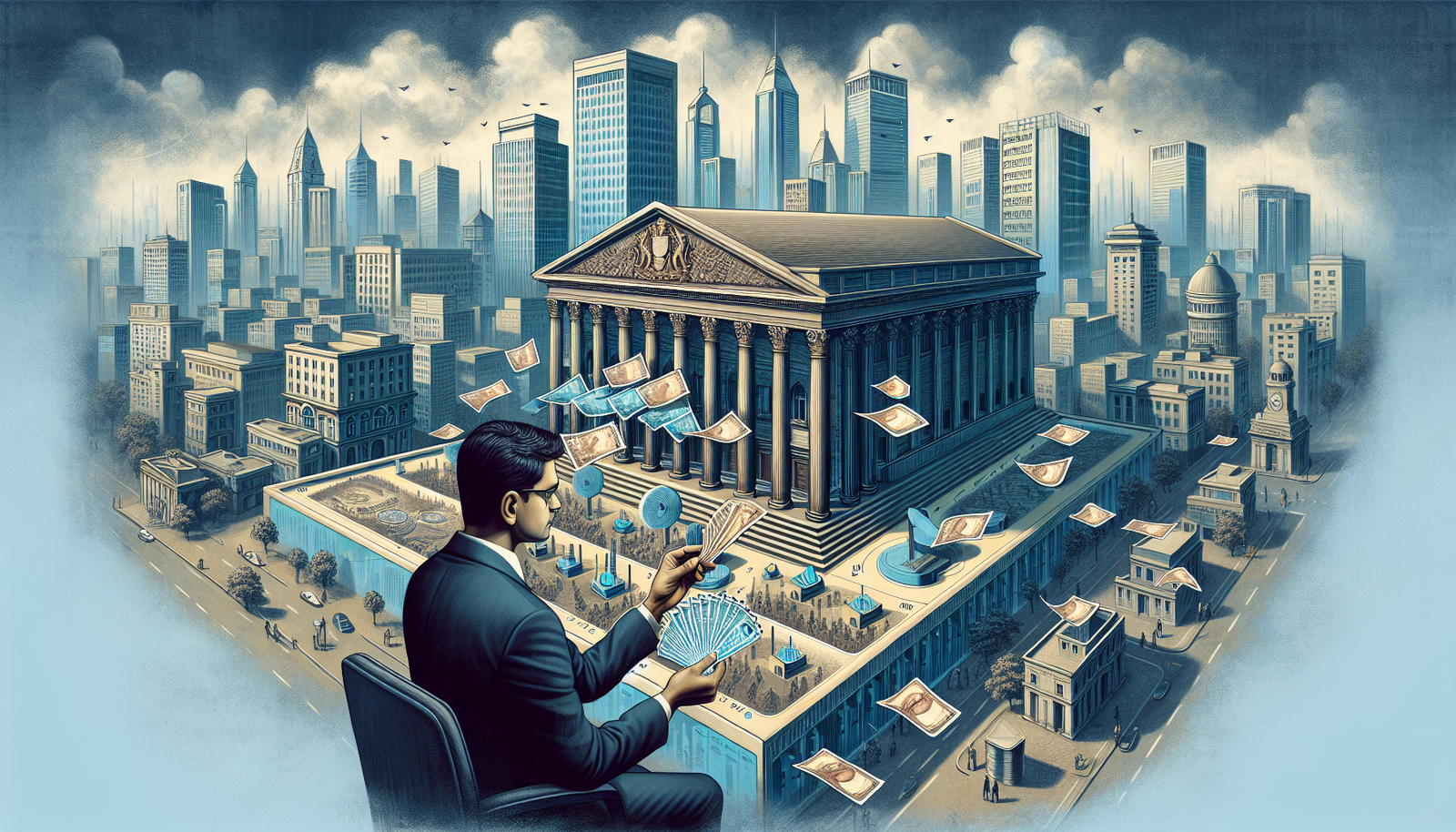
Imagine a world where money seems to grow by flowing through the veins of a system, swirling in a dance of numbers and transactions. “How Do Banks Create Money” paints this picture, seamlessly leading you through the labyrinthine mechanisms by which banks seemingly pull funds from the ether. Within the realm of finance and economics, the process of money creation is far from mundane, and learning about it can offer enlightening insights into the complexity of our modern financial systems. This article will guide you down the rabbit hole, unveiling the mystique behind banking operations and the role they play in money creation.

Understanding the Basics of the Monetary System
As you delve into the world of economics and finance, understanding the monetary system becomes fundamental to your journey. Indeed, much of the world’s economic activities are shaped and directed by this complex but fascinating system.
The Role of Banks in the Economy
Banks, your trusted transactors and guardians of your hard-earned savings, play a much bigger role than just holding onto your money. They’re the arteries of the economy, facilitating the flow of financial resources to individuals, businesses, and governments. By offering services like loans and credits, they stimulate spending and investments, thereby acting as key drivers of economic growth.
The Concept of Money Supply
Picture the money supply as a vast, pulsating ocean, ebbing and flowing with the economic tide. The concept goes beyond physical currency, embracing liquid assets readily exchangeable within an economy. These include your savings account balance, your checking account balance, and in some cases, assets like government bonds.
Understanding Fiat Money
But what exactly is money? The coins jingling in your pocket, the crisp notes you receive from the ATM, or the digital digits on your bank account – they’re all part of fiat money, a type of currency established by government regulation or law. This money has no intrinsic value – its value is derived purely from the faith and credit of the economy in which it functions.
Banking Policies and Regulations
Navigating the vast sea of the financial system are several regulatory bodies. These institutions ensure that the system is healthy, productive, and, above all, fair.
Roles and Responsibilities of Central Banks
Every nation has a central bank, an entity assigned with the intricate task of maintaining monetary and economic stability. The central bank is the lighthouse amidst the volatile waves of the economy, controlling inflation, maintaining employment levels, and ensuring the overall economic wellbeing of a nation.
Impact of Banking Laws and Regulations on Money Creation
Banking regulations can be seen as the safety measures in place on the vessel that is the monetary system. They dictate the rules of survival and behavioural conduct for commercial banks. These laws significantly influence money creation, which is fundamentally contingent on the regulatory confines within which banks operate.
Role of Government in Regulating Money Supply
Think of the government as the captain aboard the ship of finance. The government plays a pivotal role in monitoring the money supply, ensuring that the economic engines are fueled enough to drive growth, but not excessively such to instigate inflation.
Process of Money Creation in Banks
Money creation is like the beating heart of the banking system, continually pumping lifeblood into the economy.
Stage One: Deposits and Loans
The process can begin even when you casually deposit some money into your bank account. That deposit is far from idle. Banks use your deposit to generate loans and thus, create new money.
Stage Two: Multiplier Effect
This leads to the tenet of the ‘multiplier effect’. Banks only need to maintain a small portion as reserves, lending out the rest. Once this money is subsequently deposited in the bank, again, it gives rise to new loans, and thus, new money is created.
The Role of Reserve Ratios in Money Creation
The reserve ratio determines the amount banks must hold in reserve against their deposits. It also acts as a brake in the money creation process. The lower the reserve ratio, the more loans banks can make, propelling money creation.

Role of Deposits in Money Creation
The process of money creation is intrinsically linked to the practice of depositing money within the banking system.
How Deposits are Turned into Loans
Every time you deposit money into a bank, it is converted into loans for businesses or individuals, thereby creating new money. That’s the bedrock of modern banking.
Fractional Reserve Banking Explained
An integral part of this process is what’s known as ‘fractional reserve banking‘. This refers to how banks only retain a fraction of their deposits as reserves, enabling them to make new loans and thereby create money.
Impacts of Deposit Withdrawals on Money Supply
When you withdraw money from your savings, you’re reducing the bank’s ability to create new loans, hence impacting the money supply. Simply put, less money in banks equates to less money generation.
Analysis of Loans and Their Impact on Money Creation
Understanding the connection between loans and money creation is crucial to comprehending how our economy functions.
Understanding the Loan Process
The process of granting loans is a decisive factor in money creation. When a bank gives a loan, it credits your account with the loan amount, effectively creating money out of thin air.
The Impact of Interest Rates on Loans
Interest rates are a significant aspect of the loan process. They determine how appealing a loan is to potential borrowers. Lower rates encourage borrowing, hence boosting money creation, while higher rates discourage it, thereby slowing money creation.
Loan Repayments and Their Effect on Money Supply
When a loan is repaid, the process of money creation is somewhat reversed. The repaid loan diminishes the money supply as the repaid money essentially disappears from the economy.
Understanding the Fractional Reserve System
The focal point of how banks create money is the fractional reserve system, a banking system where only a portion of bank deposits are backed by actual cash-on-hand.
Historical Background of Fractional Reserve Banking
Fractional reserve banking evolved from the goldsmiths of yesteryears, who began to issue receipts for gold deposits, which over time became a widely accepted form of currency. This marked the inception of a system where deposits birthed new money.
Operations of Fractional Reserve Banks
Fractional Reserve banks primarily operate by lending more money than they hold in actual reserves. These loans transform into deposits at that or other banks, amplifying the money supply.
Risk and Benefits of Fractional Reserve System
Like any system, fractional reserve banking presents risks, primarily the risk of bank runs. Simultaneously, it is the engine propelling the gears of our economy, as it sets in motion the multiplier effect that aids money expansion.
How Central Banks Influence Money Creation
Central Banks play a crucial role in regulating and catalyzing the process of money creation.
Monetary Policy Instruments
They use powerful tools known as monetary policy instruments, such as setting reserve requirements, manipulating interest rates, and open market operations to control money creation.
Open Market Operations
Open market operations involve selling or buying government bonds to or from commercial banks. Through these activities, Central Banks can influence the reserve amounts of commercial banks, and indirectly, the money supply.
Impacts of Central Bank’s Decisions on Commercial Banks
The decisions made at the helm by Central Banks reverberate through the financial system, influencing how commercial banks operate, where they invest, and the number of loans they give, all of which significantly affects money creation.
Risks and Limitations in the Money Creation Process
While money creation is an artful process, it is not without its limitations or potential hazards.
Risks Involved in Money Creation
One of the significant risks in money creation is inflation. While growth in the money supply can stimulate economic growth, excessive creation can lead to inflation and diminished purchasing power of the currency.
Limitations of Money Creation
The primary limitation of money creation lies in its dependency on deposits. Without ongoing deposits, the capacity for banks to create new loans, and thereby new money, is significantly impeded.
Consequences of Excessive Money Creation
Excessive money creation could lead to hyperinflation – a situation where prices skyrocket, and the value of currency plummets. In the course of history, hyperinflation has crippled economies, leading to economic crises.
Real World Examples of Money Creation
Practical examples offer fascinating insights into the dynamics of money creation and its impacts on economies worldwide.
Case Studies of Money Creation
Consider the case of the “quantitative easing” policies adopted by Central Banks following the 2008 financial crisis. These measures involved large-scale asset purchases to inject significant capital into the banks, sparking off a wave of money creation.
Impacts of Money Creation on Economies
Money creation, through loans and credit, has led to significant economic expansion worldwide. However, as seen in examples like the Weimar Republic or Zimbabwe, unchecked money creation could lead to catastrophic hyperinflation.
Historical Events Influenced by Money Creation
Money creation has played a central role in numerous historical events, from financing wars to mitigating financial crisis and stimulating economic growth during recessions.
The Future of Money Creation
While banks currently dominate money creation, the future may look different, as digital innovations transform the financial landscape.
Impact of Digitalization and Cryptocurrencies on Money Creation
Digital transformation, especially the advent of cryptocurrencies, is challenging traditional money creation. While the impacts of this shift are yet to be fully understood, it represents a revolution in finance.
Proposed Reforms in the Banking Sector
Calls for reform are growing louder due to concerns over the sustainability of the existing system. Proposals such as ‘full reserve banking’ and ‘digital central bank currencies’ have gained traction.
Predicting Future Trends in Money Creation
Predicting the future of money creation isn’t easy. However, one thing is clear: as the global economy evolves, the methods of money creation will dynamically adapt, offering fascinating avenues for discourse in the ever-evolving field of economics.
Comments (1)
The Critical Role Of Cybersecurity Intelligence In Banking: 5 Key Insightssays:
October 17, 2024 at 9:37 AM[…] as internal systems, external threat feeds, and industry reports. By aggregating this information, banks can create a comprehensive view of their threat landscape. Advanced algorithms analyze this data, identifying […]